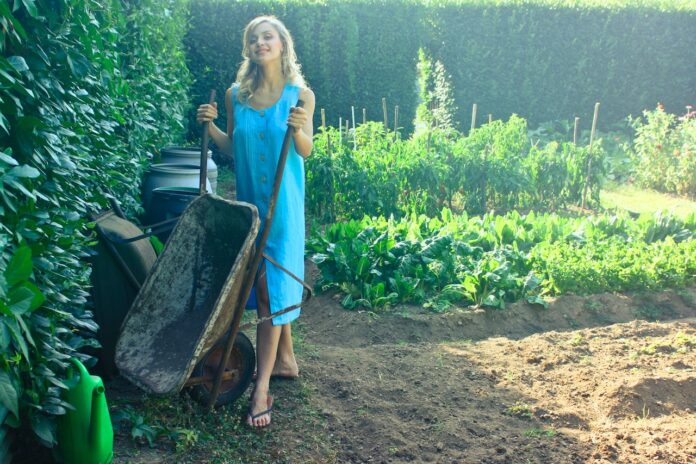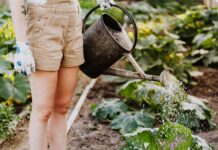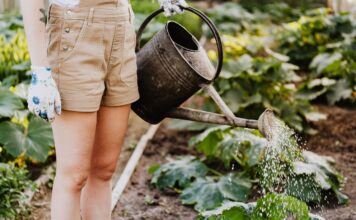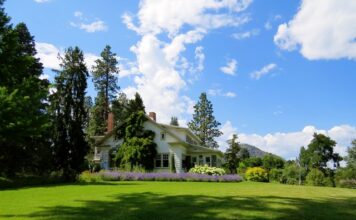In this comprehensive guide to raised bed gardening, readers will learn the benefits of this method, such as easier soil management, improved drainage, better pest control, increased yield, reduced physical strain, and an extended growing season. The article will discuss different types of raised beds, including wooden, metal, stone, brick, recycled materials, and temporary or movable options. Important planning aspects like bed size, location, walkways, accessibility, and vertical growing options are covered as well. The article will also explain how to build and maintain raised beds, including soil and fertilization tips, appropriate crop and plant spacing, and watering and irrigation techniques. Readers will also learn how to manage pests and diseases, harvest, store and preserve produce, and the best offseason practices for raised bed gardening.
Benefits of Raised Bed Gardening
Raised bed gardening offers a plethora of advantages over traditional in-ground gardening. It involves growing plants in beds, usually rectangular, that are elevated above the ground surface. Raised beds are typically framed, using materials such as wood, stone, or metal, and they contain soil and plants. Here are some key benefits of raised bed gardening.
Easier soil management
One of the main benefits of raised bed gardening is that it allows for better soil management. Raised beds can be filled with a specific soil mix tailored to your plants’ needs, ensuring they receive the appropriate nutrients and conditions for optimal growth. Moreover, because the beds are elevated, they are more accessible for gardeners, making it easier to maintain and amend the soil without having to bend down or kneel excessively. This greatly reduces the risk of soil compaction, which can inhibit plant growth. Additionally, the use of a contained area for plant growth can help prevent the spread of weeds and invasive species, as well as facilitate the practice of crop rotation to maintain soil fertility and avoid the build-up of pests and diseases.
Improved drainage
Raised bed gardening provides increased drainage capacities for your plants. This is particularly beneficial in areas with heavy clay soils or poor natural drainage, which often leave plants with waterlogged roots, leading to root rot and other diseases. In raised beds, the soil is looser, allowing excess water to drain away from the plant roots more efficiently. Moreover, amending the soil mix to include elements that improve drainage, such as sand, perlite or compost, becomes easier in raised beds.
Better pest control
The elevation of raised bed gardening can deter many common pests, such as rabbits, deer, and moles, from accessing the plants. Additionally, it’s easier to install physical pest barriers, like fencing or mesh, around raised beds. Gardens with raised beds may also have less of a problem with soil-dwelling pests like nematodes, because gardeners can control and select the soil composition. Moreover, practicing crop rotation in raised beds can help prevent the buildup of pests and diseases in the soil.
Increased yield and productivity
Raised bed gardens are known for producing higher yields compared to traditional in-ground gardens. The elevated beds provide a better soil structure, allowing plant roots to grow unrestricted and absorb nutrients more efficiently. As a result, plants are more productive and vigorous, leading to increased yield. Furthermore, the precise placement of plants in raised beds reduces space waste, enabling gardeners to grow more plants per square foot. The beds can be made more narrow, permitting gardeners to easily reach plants without stepping on the soil, thus reducing risk of soil compaction and providing a more conducive environment for plants to flourish.
Reduced physical strain
Gardening, while enjoyable, can be physically demanding. Raised bed gardening reduces the physical strain associated with traditional in-ground gardening. The elevated beds alleviate the need for excessive bending, kneeling, or stretching, making garden maintenance and harvesting easier for people of all ages and abilities, including the elderly or those with mobility issues. Moreover, adding seating along the edges of the beds, or designing the beds for wheelchair or walker accessibility, can create an even more comfortable gardening experience.
Extended growing season
Raised bed gardens can extend the growing season for gardeners. The elevated soil in a raised bed warms up faster in spring, allowing for earlier planting of crops. Additionally, raised beds are easier to cover with protective cloths or plastic to keep plants warm during cold spells, or to shade them during excessively hot weather. The improved control over soil conditions, combined with better pest management and the ability to adjust to fluctuating temperatures, can lead to a longer and more productive growing season in your raised bed garden.
Types of Raised Beds
Raised beds are a popular method of gardening, as they offer many benefits for both the gardener and the plants. They are designed in a way that allows better drainage, more efficient use of space, and easier access for gardening tasks. Raised beds can also help address soil and weed issues and provide an attractive, organized garden space. There are several types of raised beds, each with their own unique features and benefits. In this article, we will discuss five types of raised beds: wooden, metal, stone or brick, recycled material, and temporary or movable beds.
Wooden raised beds
Wooden beds are the most common type of raised bed, as they are relatively inexpensive, easy to work with, and offer a natural and rustic appearance. Many gardeners prefer using untreated, rot-resistant wood like cedar, redwood, or juniper. However, treated lumber can also be used, as long as it is certified safe for use in gardens.
Wooden raised beds are straightforward to construct, requiring simple tools and a minimal amount of expertise. They can be designed in various shapes and sizes, depending on the gardener’s preference and the available space. Some wooden raised bed kits are available for purchase, which simplifies the construction process even further. However, keep in mind that wooden beds may require maintenance over time due to weathering and potential rot or insect damage.
Metal raised beds
Metal raised beds, often made of galvanized steel or aluminum, provide a more modern and sleek look for the garden. They are highly durable, weather-resistant, and will not rot, making them an excellent long-term investment. Metal beds are also highly beneficial for retaining heat, which can create a warmer and more productive microclimate for plants.
There are some drawbacks to metal raised beds, though. They can be more expensive than wooden alternatives and may heat up too much in very hot, sunny climates, causing potential harm to the plants’ roots. Additionally, metal beds may require specialized tools and skills to construct and install.
Stone or brick raised beds
Stone or brick raised beds can create a timeless, elegant, and highly durable garden bed. When constructed properly, these beds offer excellent drainage and can last for decades without significant maintenance. Materials such as natural stone, cultured stone, or brick can be used, and various patterns and designs can be created to add visual interest to the garden.
Constructing a stone or brick raised bed can be labor-intensive and may require specialized masonry skills. Additionally, the raw materials can be quite expensive – especially if you opt for natural stone – and may drive up the overall project cost. However, the end result is a solid, long-lasting raised bed that adds value and beauty to your landscape.
Recycled material raised beds
For the environmentally conscious gardener, recycled material raised beds provide an opportunity to repurpose materials that would otherwise end up in a landfill. Commonly used materials include old pallets, reclaimed lumber, plastic containers, or even reclaimed concrete blocks. These beds can be unique, cost-effective, and environmentally responsible alternatives to traditionally constructed beds.
Keep in mind that certain precautions should be taken when using recycled materials, especially when using treated lumber. Some older treated lumber may contain harmful chemicals that can leach into the soil and negatively impact plant health. Always confirm that the lumber is safe for use in a garden setting before moving forward with construction.
Temporary or movable raised beds
Gardeners who need flexibility or anticipate needing to relocate their garden beds in the future may benefit from temporary or movable raised bed options. Portable options include grow bags, fabric pots, or plastic containers with drainage holes. These containers offer benefits such as simplicity, easy storage, and versatility in placement and design.
Design and Planning
Designing and planning a raised garden bed involve several factors, such as the size and dimensions of the beds, selecting an appropriate location, arranging multiple beds, creating walkways, and considering vertical growing options. Paying close attention to these elements will help ensure your garden’s success, ease of maintenance, and enjoyment.
Deciding on bed size and dimensions
Before you start building, consider the size and dimensions of your raised garden bed. Factors such as the available space, the types and quantities of plants you wish to grow, and your personal preferences, will influence your decision.
Ideally, raised beds should be no more than 4 feet wide, as this allows the average person to reach the center of the bed from both sides comfortably. Gardeners with mobility limitations may prefer narrower dimensions. The bed’s length can vary according to your available space and desired crop size. However, longer beds will require more support to prevent bowing or collapsing of the sides.
The height of the bed should be carefully considered, as well. Raised beds should be at least 6-12 inches deep to provide adequate root development for most plants. Taller beds, between 18-24 inches or more, provide benefits such as improved drainage, a more comfortable working height, and better control over soil conditions. However, taller beds will require more soil and may be more expensive to build.
Choosing a suitable location
Selecting an appropriate location for your raised garden beds is vital. Ensure that the area receives adequate sunlight—most vegetables and herbs require a minimum of 6-8 hours of direct sunlight per day. Observe the movement of shadows on your property throughout the day and choose a location that gets the most sun exposure.
Consider your garden’s proximity to a water source, as raised beds tend to dry out more quickly than in-ground gardens. Ensure that it is convenient to water your garden, either by hose or a nearby faucet. Assess the drainage of the area as well. Excessively wet or boggy sites may lead to issues with rot, mold, or plant diseases.
Planning for walkways and accessibility
Wide walkways are essential for accessibility around raised garden beds. Paths should be at least 3 feet wide to allow for easy movement and wheelchair access. For narrow pathways, consider installing stepping stones or small bridges to prevent soil compaction from foot traffic.
If you plan to accommodate multiple raised beds, ensure there is adequate space around each bed for maintenance and ease of movement. Consider creating a central feature, such as a seated area, workbench, or water feature, to create an inviting and practical garden space.
Arranging multiple beds and companion planting
If you’re planning for more than one raised garden bed, consider arranging them to maximize sun exposure and improve the growing environment for your plants. For example, taller plants should be planted to the north of shorter ones to prevent shading.
Utilize companion planting, where compatible plants are grown together for mutual benefits. By doing so, you can help deter pests, promote growth, and improve the overall health of your garden. Research which plants grow well together and use this information when designing your raised beds.
Considering vertical growing options
Incorporating vertical growing options into your raised bed design can save space, maximize productivity, and add visual interest to your garden. Consider planting vining plants like beans, peas, and some squash varieties along trellises, fences, or archways. Vertical structures can be placed along the bed’s edges or centrally, depending on your desired design.
Additionally, tiered designs with multiple layers or cascading planters can help you make the most out of a limited footprint. Strategically using vertical spaces will let you grow more plants in a confined area and, in some cases, improve the health of the plants by enhancing air circulation and sun exposure.
Building a Raised Bed
Preparing the site
Before you start building your raised bed, it’s essential to select a suitable location and prepare the site. Choose a spot that receives enough sunlight, ideally six to eight hours daily, and has good drainage. Avoid areas near large trees or beside structures like walls or fences that might block the sun or restrict plant growth.
Clear the area where the bed will be built by removing sod, weeds, and any rocks or debris. Use a square-edged shovel or a garden fork to dig up any unwanted vegetation. Be sure to go deep enough to ensure you’ve removed the entire root system of any weeds or grass.
After clearing the area, level the ground as evenly as possible. Use a garden rake to smooth out the soil and ensure there are no more dips or bumps. If your yard slopes, you may need to excavate some soil to create a flat platform for the raised bed. Once the ground is prepared, measure the area and mark off the dimensions of the raised bed with stakes or string.
Gathering materials and tools
The next step is to gather the materials needed to construct the bed frame. Preferably, use lumber that is rot-resistant, such as cedar, redwood, or composite wood. Treated wood is not recommended, as it can leach harmful chemicals into the soil that can then be absorbed by plants. You’ll also need wood screws, corner brackets or braces, and optional decorative caps for the corners.
Some tools you’ll need include a tape measure, saw (if making any cuts), drill or screwdriver, wood screws, level, and a square. You may also want to have gloves, a hammer, and a stake for marking the dimensions of the bed.
Constructing the bed frame
Begin by cutting the lumber to the desired size of your raised bed. You can personalize the dimensions to fit your space and make the bed as large or small as you wish. Keep in mind that a width of 4 feet (1.22 meters) or less is ideal, as it allows you to reach the middle of the bed without stepping on the soil.
Once the lumber is cut, lay out the pieces to ensure you have everything you need. Take the time to ensure that the corners of the frame are square by using a carpenter’s square or the 3-4-5 method, which involves measuring 3 feet along one side of the corner, 4 feet along the adjacent side, and ensuring that the diagonal between these two points measures exactly 5 feet.
Secure the corners with wood screws and corner brackets or braces. Drill pilot holes to avoid splitting the wood and use screws that are long enough to hold the boards securely. After attaching all the sides, use a level to check that the frame is level.
Adding a weed barrier (optional)
To help prevent weeds from growing in your raised bed, you can add a weed barrier at the base. This can be made from several layers of overlapping newspaper or cardboard, or you can use landscape fabric. Lay the material directly on the ground inside the bed frame, ensuring it covers the entire area. Remember to overlap the edges to prevent gaps where weeds could sprout.
Filling the bed with soil and organic matter
Now that the frame is in place and the weed barrier is laid (if using), it’s time to fill the bed with soil. A high-quality mixture of topsoil, compost, and other organic matter is recommended. This mixture will provide your plants with essential nutrients, help retain moisture, and improve drainage.
Start by adding a layer of bulky organic matter, such as straw, leaves, or small branches, at the bottom of the bed. This will help improve drainage, especially if your bed is tall. Next, fill the bed halfway with a mixture of topsoil, compost, and other organic materials like aged manure, peat moss, or vermiculite. Thoroughly mix these components and then fill the bed the rest of the way, leaving about 2 inches from the top.
Smooth out the soil, ensuring it’s level and evenly distributed. Finally, water the bed thoroughly to settle the soil and prepare it for planting. Once your raised bed is filled, it’s ready for plants or seeds, and you’re on your way to a thriving garden.
Soil and Fertilization
Importance of soil quality and structure
Soil quality and structure are vital components for the growth and development of plants. A good quality soil provides essential nutrients, water, and oxygen to plants, ensuring their health and productivity. The composition of the soil influences the type of plants that can be cultivated, as well as the available fertility and nutrient content.
Soil structure, on the other hand, refers to the arrangement of soil particles into aggregates or clumps. A well-structured soil promotes proper aeration, ensuring that plants can get enough oxygen for respiration. Adequate soil structure also promotes good water retention and drainage, preventing either waterlogging or drought. Additionally, it provides a suitable habitat for various microorganisms, which play crucial roles in maintaining soil fertility and organic matter composition.
Soils with poor quality or structure can lead to reduced plant growth, increased erosion, and nutrient deficiencies, among other issues. As a result, understanding the importance of maintaining good soil quality and structure is crucial for any gardener or farmer, as it directly impacts the health and productivity of the plants.
Types of soil mixtures and amendments
To ensure healthy plant growth, it is essential to create the ideal soil mixture or amend existing soil, depending on the specific needs of the plants being grown. Some common soil mixtures and amendments include:
- Loam Soil: This type of soil is a well-balanced mixture of sand, silt, and clay, and is considered ideal for most plant growth because it provides good water retention, drainage, and aeration. It is rich in organic matter and nutrients that support plant growth.
- Sandy Soil: This soil type contains a high proportion of sand particles and is characterized by low water retention and poor fertility. However, it has excellent drainage and aeration, making it suitable for drought-tolerant plants like cacti and succulents. You can improve sandy soil by adding compost or other organic matter to increase its water retention and nutrient content.
- Clay Soil: High in clay particles, this type of soil generally has poor drainage and aeration, which can cause root rot and suffocate plants. However, clay soil is rich in nutrients, so improving its structure with the addition of organic matter like compost, or sand will boost drainage and aeration, making it more suitable for plant growth.
- Peat-based Soil Mixtures: These mixtures contain a high proportion of decomposed organic materials, such as peat moss. Peat-based soil mixtures are well-draining, lightweight, and have excellent water retention, making them ideal for container planting.
- Soil Amendments: Compost, manure, and other organic matter can be used to amend soil and improve its properties, such as increasing nutrient content, improving water retention and drainage, and enhancing soil structure.
Fertilization requirements and options
Fertilization is essential to ensure optimal plant growth and the production of healthy fruits, flowers, and vegetables. It replenishes nutrients that are removed or consumed by plants, microbial processes, or erosion. Different plants have varying fertilization requirements depending on their growth stages and nutritional needs. Some common fertilization options include:
- Organic fertilizers: Derived from natural sources like compost, manure, or bone meal, organic fertilizers are environmentally friendly and can help improve soil structure along with providing essential nutrients.
- Chemical (inorganic) fertilizers: These are synthetically produced and contain concentrated nutrients that are easily absorbed by plants. They are available in various formulations tailored to specific plant needs but can sometimes cause harm to the soil’s microbial activity and the environment if not used properly.
- Slow-release fertilizers: Available in both organic and inorganic forms, slow-release fertilizers release nutrients gradually over time, providing a steady supply, and minimizing the risk of over-fertilization.
- Liquid fertilizers: These fertilizers are highly soluble and can be easily applied to the soil or directly to the plant’s foliage, providing quick nutrient uptake.
Regular soil maintenance and replenishment
To maintain healthy soil, it is essential to incorporate regular soil maintenance and replenishment practices. Some of these practices include:
- Periodic testing of soil pH, nutrient content, and texture to monitor changes and make necessary adjustments.
- Adding organic matter like compost, well-rotted manure, or cover crops to maintain and improve soil structure, fertility, and microbial activity.
- Rotating crops or planting different plants in the same area to avoid nutrient depletion and reduce the buildup of pathogens and pests.
- Applying organic mulch to the soil surface to help retain moisture, suppress weeds, and gradually contribute organic matter as it decomposes.
- Practicing no-till or low-till gardening methods to reduce soil disturbance and prevent erosion.
By prioritizing the importance of soil quality, structure, and fertilization, gardeners and farmers can create a thriving environment for their plants and ensure a successful, bountiful harvest.
Planting in Raised Beds
Raised beds offer numerous benefits for home gardeners, including improved drainage, soil quality, and ease of maintenance. Planting in raised beds can provide a more controlled environment for your plants, leading to better yields and less work over time. In this article, we will discuss selecting appropriate crops for raised beds, plant spacing, and organization, as well as timing for planting and succession planting. We will also share some helpful tips and techniques to make planting in raised beds a breeze.
Selecting Appropriate Crops for Raised Beds
When deciding which plants to grow in your raised beds, consider the following factors: the size of your raised bed, the climate in your area, and the plants’ growing requirements. Raised beds are particularly suitable for plants that require a lot of root space and well-draining soil, such as root vegetables, tomatoes, and cucumbers.
Some popular vegetables to grow in raised beds include:
- Leafy greens: lettuce, spinach, kale, and Swiss chard are all ideal for raised beds. They have shallow root systems and can be closely spaced together, allowing for a high yield in a small space.
- Root vegetables: carrots, beets, and radishes all thrive in the loose, well-draining soil of raised beds. These vegetables can also be planted in succession for a continuous harvest.
- Beans, peas, and cucumbers: these vining plants can benefit from the improved soil and growing conditions in raised beds, particularly when given a trellis or support structure to climb on.
Plant Spacing and Organization
Proper plant spacing is crucial for healthy plant growth and optimal yields in raised beds. Overcrowding plants can lead to a lack of light, airflow, and nutrients, causing smaller yields and an increased risk of disease. When planting in raised beds, follow these guidelines for plant spacing:
- Plant seeds or seedlings at the recommended distance from each other, as indicated on the seed packet or plant label. Less vigorous plants will often require less space, while larger vegetables like tomatoes, peppers, and eggplant require more.
- Plant in a grid pattern, rather than rows. This allows for more efficient use of space and ensures that plants receive adequate sunlight and airflow.
- Use companion planting to maximize space and improve plant health. Planting certain crops together can help deter pests, improve soil fertility, and even enhance flavor.
Timing for Planting and Succession Planting
Timing is essential for a successful harvest, especially in raised beds where space is limited. Plant cool-season crops, such as lettuce, spinach, and peas, as soon as the soil can be worked in the spring. Warm-season vegetables, like tomatoes, peppers, and cucumbers, should be planted once the danger of frost has passed and soil temperatures have warmed up.
To ensure a continuous harvest throughout the growing season, implement succession planting. This involves planting a new crop as soon as the prior crop has been harvested. For example, once the spring lettuce harvest finishes, plant a warm-season crop like bush beans or zucchini in its place.
Planting Tips and Techniques
Follow these tips and techniques for successful planting in raised beds:
- Prepare the soil: Raised beds provide excellent drainage and soil quality, but it’s important to mix in organic matter, such as compost or well-rotted manure, to improve soil fertility.
- Mulching: Add 2-3 inches of organic mulch, like straw or shredded leaves, around your plants to help retain moisture, suppress weeds, and regulate soil temperature.
- Water deeply and consistently: Raised beds tend to dry out more quickly than in-ground gardens, so water your plants – ideally with a soaker hose or drip irrigation system – to a depth of 6-8 inches.
- Regularly check for pests and disease: Inspect your plants for signs of pests or disease, and address any issues promptly to prevent them from spreading.
By following these guidelines and tips, you can successfully plant and maintain a thriving raised bed garden. Remember to choose appropriate crops for your raised beds, follow recommended plant spacing and organization, and stay mindful of planting timing and succession planting to enjoy a bountiful harvest throughout the growing season.
Watering and Irrigation
Raised bed gardens have become increasingly popular due to their many benefits, including improved soil drainage, reduced weed growth, and increased adaptability to various growing conditions. However, proper watering and irrigation are essential to maintaining the health and productivity of your raised bed garden. In this section, we’ll discuss the water requirements for raised bed gardens, manual watering techniques, drip irrigation systems, and some water-saving strategies and best practices.
Water requirements for raised bed gardens
Watering is a critical aspect for the success of any garden, and raised beds are no exception. The water requirements for raised bed gardens may vary depending on factors such as the type of plants being grown, the size of the bed, and the soil composition. However, some general guidelines can help ensure proper watering:
- Regular watering: Raised beds typically have a faster drainage rate than in-ground gardens, so they may require more frequent watering. By observing your plants and checking the soil moisture, you can determine how often to water. A good rule of thumb is to water when the top inch of soil feels dry to the touch.
- Adequate water volume: Plants in raised beds need sufficient water to reach their root zone. As a general guideline, apply 1 to 1.5 inches of water per week to provide a consistent, deep watering that promotes healthy root growth.
- Time of day: It’s best to water your raised bed garden early in the morning or late in the afternoon when temperatures are cooler. This helps to minimize water loss due to evaporation and ensures that the water penetrates the soil effectively.
Manual watering techniques
Manual watering, such as with a hose or watering can, is a common method for maintaining raised bed gardens, especially for smaller garden spaces. Here are some tips for effective manual watering:
- Use a gentle spray: Attach a nozzle or spray head to your hose that provides a soft, rain-like spray to prevent soil compaction and erosion.
- Water at the base of plants: Direct the water at the base of the plants to ensure it reaches the root zone, rather than watering the leaves, which can promote the growth of mold and mildew.
- Soak the soil thoroughly: Allow the water to penetrate the soil deeply, so the roots can absorb it properly. Avoid shallow watering, which can lead to surface rooting and stress on the plants.
Drip irrigation systems
Drip irrigation is an efficient way to water your raised bed garden, as it delivers water directly to the root zone of your plants, reducing water waste and promoting healthier plant growth. Consider these benefits of drip irrigation systems for raised beds:
- Water conservation: Drip irrigation uses up to 50% less water than traditional watering methods, making it an eco-friendly choice for your garden.
- Customizable design: Drip irrigation systems can be easily customized to fit the unique layout of your raised bed garden and meet the watering needs of your plants.
- Improved plant health: Since drip irrigation enables consistent, deep watering, your plants will develop stronger root systems and be less susceptible to pests and diseases.
- Easy installation and maintenance: Drip irrigation systems can be easily installed and maintained, and many are available as DIY kits for a quick and convenient setup.
Water-saving strategies and best practices
Conserving water in your raised bed garden is essential for achieving maximum efficiency and long-term sustainability. Follow these best practices to minimize water waste and ensure adequate moisture for your plants:
- Use mulch: Adding a layer of mulch to the surface of your raised bed will help retain moisture, suppress weed growth, and moderate soil temperatures. Organic mulches such as straw, wood chips, or shredded leaves are all suitable options.
- Choose drought-tolerant plants: Opt for plants that can withstand periods of limited water availability, such as succulents, herbs, and drought-tolerant vegetables.
- Amend your soil with organic matter: Adding organic material like compost to your soil will improve its water-holding capacity and support overall plant health.
- Monitor and adjust your watering schedule: Pay close attention to weather conditions, rainfall, and daily evaporation rates, and adjust your watering schedule as necessary to conserve water and keep your plants healthy.
By implementing these watering and irrigation strategies and best practices, you can maintain a thriving, water-efficient raised bed garden that not only conserves natural resources but also promotes healthier plants and higher yields.
Pest and Disease Management
Pest and disease management is an essential aspect of maintaining a healthy and productive raised bed garden. With proper care and attention, you can prevent and control common pests and diseases, ensuring a thriving and bountiful harvest.
Common pests and diseases in raised beds
Raised beds can attract a variety of pests and diseases, depending on the plants you’re growing and the local environment. Some common pests and diseases include:
- Aphids: Small sap-sucking insects that can cause yellowing, distortion, or curling of leaves, as well as lower crop yields.
- Slugs and snails: These pests can cause significant damage to tender leaves and stems, especially in young plants.
- Spider mites: Tiny insects that can weaken plants by feeding on their sap and causing leaf damage.
- Caterpillars: Many types of caterpillars can feed on a wide range of plants, causing a loss of foliage or direct damage to produce.
- Powdery mildew: A fungal disease that appears as white powdery patches on the leaves and stems of plants, which can eventually cause leaves to die.
- Blight: A group of fungal diseases that can cause significant damage to crops, including tomatoes, potatoes, and peppers.
Preventative measures and cultural practices
Practicing good garden hygiene and employing preventive measures can go a long way in keeping pests and diseases at bay in your raised bed. Here are some tips:
- Choose resistant varieties: Some plants have been bred to resist specific pests and diseases, making them better-suited for certain environments.
- Provide proper spacing between plants: Overcrowding can create favorable conditions for pests and diseases, as well as reducing air circulation.
- Rotate crops: Rotating where you plant different types of vegetables can prevent build-up of soil-borne diseases and pests.
- Maintain healthy soil: Healthy soil promotes vigorous plant growth and helps plants resist pests and diseases. Regularly add organic matter and ensure that your raised bed has proper drainage.
- Water in the morning: Damp conditions at night can promote the growth of fungal diseases. Watering in the morning allows plants to dry out before nightfall.
- Keep a clean garden: Rake up fallen leaves and debris, and remove dead and dying plants promptly to reduce potential hiding spots and breeding grounds for pests and diseases.
Natural and organic pest control methods
There are several non-toxic and eco-friendly methods for managing pests and diseases in your raised bed garden:
- Hand-picking: Remove pests like caterpillars, slugs, and snails by hand and dispose of them.
- Natural predators: Encourage beneficial insects like ladybugs, lacewings, and predatory mites to help control pests.
- Organic insecticides: Use neem oil, insecticidal soap, or other organic products to control pests without harming beneficial insects.
- Biological controls: Introduce natural predators, such as nematodes, to control pests like slugs and snails.
- Homemade remedies: Use diluted garlic, neem oil or vinegar as a natural deterrent spray for insects and fungal diseases.
- Physical barriers: Employ floating row covers or copper tape to protect plants from pests.
Monitoring and reacting to issues
Regular monitoring and early detection of pests and diseases are crucial for successful management. Inspect your raised bed garden regularly, looking for signs of infestation or infection. A few proactive steps include:
- Quarantine new plants: Keep new plants away from your raised bed for a week or two to ensure they’re not harboring pests or diseases.
- Monitor regularly: Inspect your plants’ leaves, stems, and fruits for signs of damage or the presence of pests.
- Deal with issues promptly: At the first sign of trouble, take action to prevent further damage or spread.
- Record problems and successes: Keep a garden journal to track issues and successes, so you can learn from your experiences and adapt your practices over time.
- Seek help when needed: Consult local gardening groups, extension services, or experienced gardeners for advice on dealing with specific pests and diseases.
By employing preventative measures, utilizing natural and organic pest control methods, and consistently monitoring your raised bed garden, you can effectively manage pests and diseases and ensure a thriving, bountiful harvest.
Harvesting and End of Season Care
Harvesting tips and timing
Harvesting your garden’s produce is not only exciting and rewarding but also a crucial part of gardening itself. To ensure the highest quality fruits and vegetables, it’s important to harvest them at the right time, and ensure proper care towards the end of the season.
The ideal time to harvest depends on the type of crop you have planted. In general, you should harvest vegetables and fruits when they are at their peak maturity, which can be determined by paying careful attention to their appearance, taste, and texture.
Here are some general harvesting tips and timing for common garden crops:
- Leafy greens (lettuce, spinach, kale, etc.): Harvest when leaves are tender and large enough to eat, but before they start to bolt (form flower stalks). This is typically when they’re young and tender, usually around 4 to 6 weeks after planting.
- Root vegetables (carrots, beets, radishes, etc.): Harvest when the roots are the desired size, usually 2 to 3 months after planting. It is better to harvest these crops before they become woody and bitter.
- Tomatoes: Harvest when they are fully colored and firm to the touch. To ensure the best flavor, allow them to ripen on the vine.
- Peppers: Harvest when they reach their ideal size and color. Green bell peppers, for instance, can be harvested when they are firm and glossy.
- Zucchini and squash: Harvest when they are between 6 to 8 inches long, and the skin is still tender.
Ensure that you use clean, sharp tools or your hands for harvesting, and handle your produce with care to avoid bruising or damaging. Harvesting in the morning or evening, when temperatures are cooler, can help retain freshness.
Storing and preserving your produce
Once you have harvested your garden’s bounty, it’s essential to store and preserve it properly to maintain quality, taste, and nutrition. Proper storage methods vary depending on the specific crop.
Here are some general storage and preservation tips for common garden produce:
- Store produce in a cool, dry place, like a pantry or basement, where there is good air circulation, and temperatures are consistent. Warmer fruits and vegetables, like tomatoes and peppers, should never be refrigerated.
- Preserve your harvest by canning, freezing, or dehydrating to enjoy your fruits and veggies throughout the year.
- Consider vacuum-sealing or using a food saver to extend the shelf life of your produce.
- Follow proper techniques for canning and pickling, such as using a water bath for high-acid fruits, and pressure canning for low-acid vegetables.
Preparing beds for winter and offseason care
As the growing season comes to an end, it’s important to care for your garden beds and soil to ensure a healthy and productive return the following year. Winterize your garden by following these steps:
- Remove all dead plants and weeds to help prevent diseases and pests from overwintering in the soil.
- Amend your soil by adding compost or organic matter to restore nutrients and improve soil structure. This can be done by applying a layer of compost, well-rotted manure, or leaf mold to the beds.
- Plant cover crops, such as clover, alfalfa, or winter rye, to protect the soil from erosion, suppress weeds, and add nutrients back into the ground.
- Mulch garden beds with a layer of straw, leaves, or other organic material to insulate the soil and protect plant roots from harsh winter conditions.
Rotating crops and maintaining soil health
Crop rotation is a vital practice in maintaining soil health, managing pests, and preventing diseases in your garden. By rotating crops every year, you can help break disease and pest cycles and promote nutrient-rich soil.
A simple way to implement crop rotation is to divide your garden into sections based on plant families, such as legumes, brassicas, nightshades, and root crops. Each year, move the plants in each section to a new section, changing the order of the plant families.
To further improve soil health, regularly amend your soil with organic matter, such as compost or well-rotted manure, and maintain a living root in the ground by planting cover crops during the offseason.
By following these steps for harvesting and end-of-season care, you can enjoy a steady supply of fresh produce while maintaining a healthy and fruitful garden for years to come.
What are the benefits of raised bed gardening?
Raised bed gardening offers significant advantages over traditional in-ground gardening. Benefits include improved soil drainage, higher yields, reduced soil compaction, fewer weeds, easier maintenance, and earlier planting dates due to warmer soil (Miller, Saranack, & Sebold, 1995).
What materials can be used for constructing raised beds?
Several materials can be used for constructing raised beds, including wood, concrete blocks, galvanized steel, and plastic lumber. Each material has its benefits and drawbacks, so the choice will largely depend on preferences, budget, and durability requirements (Krasny, 2017).
How deep should a raised bed be for optimal plant growth?
A raised bed should ideally be between 12-18 inches deep. This depth supports healthy root growth and ensures adequate moisture retention for most plants (Miller, Saranack, & Sebold, 1995). However, the specific depth required may vary depending on the plants being grown.
How do I prepare the soil for a raised bed garden?
To prepare the soil, first remove any existing grass and weeds from the area. Then, fill the raised bed with a nutrient-rich soil mix, comprising equal parts compost, peat moss or coco coir, and coarse vermiculite or perlite. This mix promotes drainage and fertility (Callan, 2007).
What types of plants can be grown in raised beds?
Almost all vegetables, fruits, herbs, and flowers can thrive in raised beds. From leafy greens like lettuce and kale to root vegetables like carrots and radishes, raised bed gardening offers suitable growing conditions for diverse plant varieties (Krill, 2019).
How often should I water my raised bed garden?
Watering frequency depends on factors like climate, soil type, and the plants being grown. In general, raised bed gardens require more frequent watering than in-ground gardens, as they tend to dry out quickly. Monitor the soil moisture regularly, and water when the top inch feels dry (Deacon, 2016).












